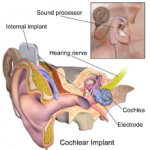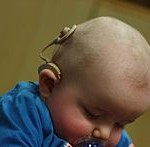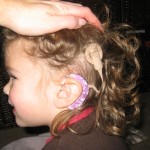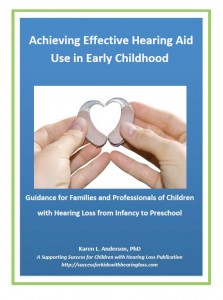Related Products
For Professionals
- Amplification
- Assessment of Student Skills, Challenges, Needs
- Early Childhood: Infants, Toddlers, Preschool
- Hearing Loss – Identification, Impact and Next Steps
- IDEA Law Summary Information
- Language and Speech Development Issues
- Legal Issues in Serving Children with Hearing Loss
- Listening (Auditory Skills) Development
- Planning to Meet Student Needs
- Self-Advocacy Skills for Students with Hearing Loss
- Self-Concept: How the Child with Hearing Loss Sees Himself
- Social Skills
- Speech Perception & Learning
Related Teacher Tools Takeout Items
Cochlear Implants
Cochlear implants are an option for children who have very little hearing and receive little or no benefit from hearing aids. Refer to Cochlear Implants – What, When, Why, How for additional basic information. Videos that describe a cochlear implant and how it works: Khan Academy YouTube video Advanced Bionics YouTube video; CID QUICK TIPS VIDEO: Cochlear Implant Components
Strategy for fastening, securing and decorating CI processors
Parts of the cochlear implant
The implant is surgically placed under the skin behind the ear. The basic parts of the device include:
 External:
External:
- one or more microphones which picks up sound from the environment
- a speech processor which selectively filters sound to prioritize audible speech, splits the sound into channels and sends the electrical sound signals through a thin cable to the transmitter,
- a transmitter, which is a coil held in position by a magnet placed behind the external ear, and transmits power and the processed sound signals across the skin to the internal device by electromagnetic induction,
- Internal:
a receiver and stimulator secured in bone beneath the skin, which converts the signals into electric impulses and sends them through an internal cable to electrodes,
- an array of more than 20 electrodes wound through the cochlea, which send the impulses to the nerves in the scala tympani and then directly to the brain through the auditory nerve system. There are 4 manufacturers for cochlear implants, and each one produces a different implant with a different number of electrodes. The number of channels is not a primary factor upon which a manufacturer is chosen; the signal processing algorithm is the important factor.
Candidates
There are a number of factors that determine the degree of success to expect from the operation and the device itself. Cochlear implant centers determine implant candidacy on an individual basis and take into account a person’s hearing history, cause of hearing loss, amount of residual hearing, speech recognition ability, health status, and family commitment to aural habilitation/rehabilitation.
A prime candidate is described as:
 having severe to profound sensorineural hearing loss in both ears.
having severe to profound sensorineural hearing loss in both ears.- having a functioning auditory nerve
- having lived at least a short amount of time without hearing (approximately 70+ decibel hearing loss, on average)
- having good speech, language, and communication skills, or in the case of infants and young children, having a family willing to work toward speech and language skills with therapy
- not benefitting enough from other kinds of hearing aids, including latest models of high power hearing instruments and FM systems
 having no medical reason to avoid surgery
having no medical reason to avoid surgery- living in or desiring to live in the “hearing world”
- having realistic expectations about results
- having the support of family and friends
- having appropriate services set up for post-cochlear implant aural rehabilitation (through a speech language pathologist, deaf educator, or auditory verbal therapist).
The Parts of the Cochlear Implant and Candidates information above was excerpted from Wikipedia.
One Cochlear Implant or Two?
For children who have severe to profound hearing loss in both ears (75 dB or worse) a common question is whether just one cochlear implant will be enough for the child to learn. For information on the impact of hearing with just one ear refer to the information on this website about unilateral hearing loss as the listening challenges are the same for children hearing only in one normal-hearing ear as they are for children with bilateral hearing loss who use a hearing device in only one ear.
Research Findings on one vs. two Cochlear Implants
A five-year study, published in the journal Ear and Hearing, was conducted across Victoria, New South Wales, Queensland, South Australia, and New Zealand, involving cochlear implant clinics and early intervention centers with more than 160 children. They found that children with hearing loss who were fitted with a second cochlear implant early in life developed better language skills.“Children in this study with bilateral CIs developed vocabulary and spoken language significantly faster than children with only one CI. This has enormous implications for their long-term future.”
Recently, the New Zealand Health Department recommended a change of the current federal funding policy in favor of having all hearing-impaired children younger than the age of six years fitted with bilateral implants.
Information on predicting long-term outcomes. This information can be useful when establishing expectations for intensity of services and improvements in communication for all types of potential CI candidates.
CID QUICK TIPS VIDEO – Troubleshooting a Cochlear Implant
What about a Cochlear Implant for a Child with Single-Sided Deafness?
A 2014 Hearing Review article described cochlear implantation for a child with single sided deafness.
Identified difficulty listening issues:
–Understanding soft speech (whispers) –Listening in a large room –Hearing teacher when her back was turned –Many situations when noise is present –Issues in some social situationsThe following comments were by the 10-year-old child who received an implant in her deaf ear:
Before [my cochlear implant], it was normal for me to hear things differently, like “girled cheese” vs “grilled cheese” or “fork “ vs “pork.” I tried out for the school spelling bee but didn’t make it because my teacher had to repeat the words over and over again.”
“In small groups, it was hard to hear my classmates because we have to whisper. I always had to position myself in the classroom so I could hear my teacher. I couldn’t hear my teammates or coach when at practice or playing a game. They would have to yell or tap me on my shoulder to get my attention….. I am much more confident. I’m glad I got a cochlear implant and wouldn’t want to give [it] back.”
Cochlear Implants + FM/DM Devices
Fitting an FM/DM system to a student with hearing loss can be tricky as mixing ratios can vary based on student preference. Be sure to do some evaluations (i.e., Functional Listening Evaluation using the harder, nonsense materials as you vary the mixing ratios). Resource.
- Some students have 50/50 (equal input from FM/DM and environmental mic) bilaterally
- Some prefer all FM/DM on one side and all environmental mic on the other
- Some our CI students do so well with their CIs (and don’t like missing information that is off-mic such as in discussions) that they don’t use any FM
- Some ratios may be preferred with traditional systems (i.e., 50/50) and different when a student tries the Roger Pen system (i.e. all Roger on one side and 50/50 on the other side so the student can hear his/her own voice). Per Tina Childress, educational audiologist.
Updated January 2016.





